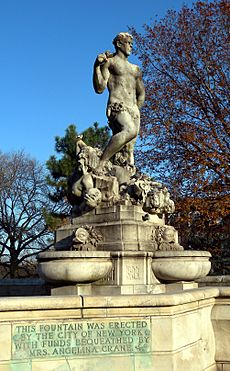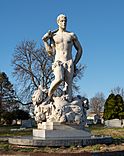Civic Virtue facts for kids
Quick facts for kids Civic Virtue |
|
|---|---|
| Civic Virtue Triumphant Over Unrighteousness | |

The statue in front of New York City Hall, lower left, with the Manhattan Municipal Building behind it, 1922
|
|
| Artist | Frederick William MacMonnies |
| Year | 1909–1922 |
| Medium | Marble |
| Dimensions | 5.2 m (17 ft) |
| Location | New York City |
| 40°42′51″N 73°49′47″W / 40.714198°N 73.829788°W | |
| Owner | Green-Wood Cemetery |
Civic Virtue Triumphant Over Unrighteousness (1909–1922) is a famous sculpture and fountain in New York City. It was created by sculptor Frederick William MacMonnies and architect Thomas Hastings. The Piccirilli Brothers carved the artwork from marble.
This large sculpture has moved a few times. It was first placed in front of New York City Hall in Manhattan. Later, it spent about 72 years next to Queens Borough Hall in Queens. Today, the main sculpture group can be found in Green-Wood Cemetery in Brooklyn.
Contents
Understanding the Civic Virtue Sculpture
The "Civic Virtue" fountain was ordered in 1909 by Mayor George B. McClellan, Jr.. Money for the project came from a gift left by Angelina Crane. The entire artwork cost US$90,000 to finish.
What the Sculpture Shows
The sculpture group is 17 feet tall and made of marble. It shows a large male figure, often called "Civic Virtue." He holds a sword on his shoulder. This figure stands over two female figures that look like they are struggling. These female figures represent "Vice" and "Corruption."
The female figures are like sirens from old stories. They have the heads and bodies of women but the tails of serpents. They are tangled in their own nets, showing they failed to trick the man. Many people thought the male figure was Hercules, a strong hero from Greek myths.
The Model for Civic Virtue
There's a story that the famous bodybuilder Charles Atlas posed for the male figure. However, a newspaper article from 1922 says the model was actually Edward Raffo. He was an Italian-American bicyclist.
The Fountain's Design
The sculpture group stood on a square base. This base had dolphin heads that sprayed water into basins on its sides. The water then flowed from these basins into a pool. The pool was shaped like an unusual cross and sat on three steps.
The Statue's Time in Manhattan
The Angelina Crane Fountain was put in front of New York City Hall. It was officially shown to the public on April 20, 1922.
Artist's Response to Critics
The sculptor, Frederick MacMonnies, later spoke about his work. He said that in many artworks, men often give in to temptation. He believed his sculpture showed a man who found the strength to resist. He felt that showing a man overcoming temptation was a strong message. He explained that using figures like sirens to represent bad things is a common way to tell a story in art.
Moving the Statue: From Manhattan to Queens
The sculpture did not stay in Manhattan forever. Mayor Fiorello H. La Guardia, who was mayor from 1934 to 1945, really disliked the statue. He even called it "Fat Boy."
Why the Statue Moved
When Queens built a new Borough Hall in 1940, Mayor La Guardia saw a chance to move the statue. He decided to give the fountain to Queens. In February 1941, the sculpture was moved from Manhattan.
The fountain was then set up in Kew Gardens. It was placed at Queens Boulevard and Union Turnpike, right next to the new Borough Hall. The statue was officially unveiled in its new home on May 29, 1941.
Discussions in Queens
Over the years, the statue sparked many conversations. In 1972, a group of people held a demonstration at the fountain. They wanted to share their views on how the statue showed women.
In 1987, Claire Shulman, who was the first woman president of Queens, suggested moving the statue again. She felt that a government building was not the right place for a statue that seemed to show women in a negative way.
Deterioration and Final Move
The marble sculpture and fountain started to wear down over time. Queens did not have enough money to fix it.
In 2011, former Congressman Anthony Weiner spoke at the fountain. He also believed the statue should be moved because of how it showed women. He even joked about selling it online.
Finally, Green-Wood Cemetery agreed to take the sculpture. On December 15, 2012, the sculpture group was moved from Queens Borough Hall. It was taken to the cemetery grounds in Brooklyn, but without its original pedestal and pool.





